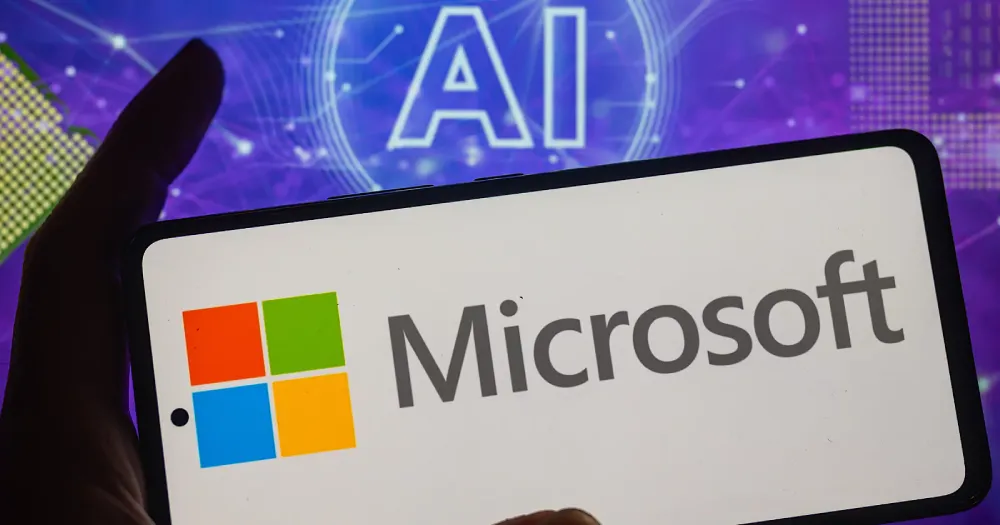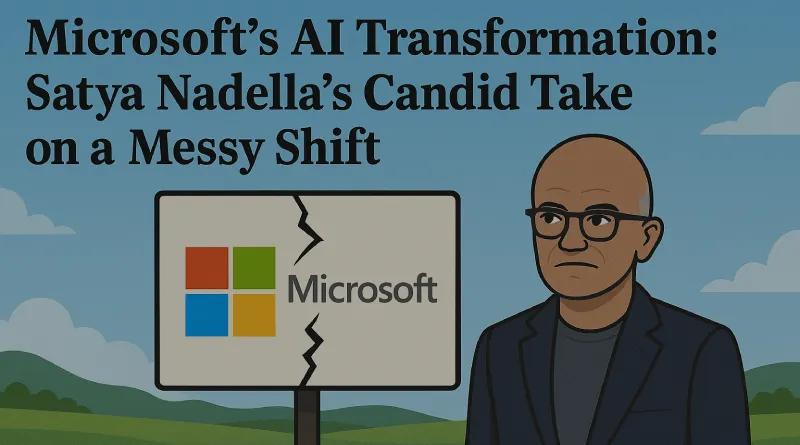Microsoft’s AI Transformation: Satya Nadella’s Candid Take on a Messy Shift
Introduction
When the idea of artificial intelligence (AI) remodeling industries is a reality, Microsoft will already be in the lead, and its massive assets will have become the means to an AI-based world. Nonetheless, there has been a death toll to this great shift. In 2025, Microsoft has fired more than 15,000 workers, of which 9,000 were fired in July alone, and the CEO, Satya Nadella, has to deal with both the emotional and strategic difficulties of such a transition. Addressing employees in an emotive memo, Nadella termed the exercise as a mess but a necessary one with the ironic twist of a successful corporation having to take drastic steps on staff. The article will explore the specifics of the way Microsoft transformed and present you with exclusive information on the implications this has on the technological business as well as how this has changed the local scene and what it means to the employees and the stakeholders.
The Emotional Weight of Layoffs
The memo by Nadella to the 228,000 workforce at Microsoft was sent in June 2024, and it recognized the human cost of the layoffs. Some of the most challenging decisions that we have to make are such. They touch people we have known and loved and worked with and so on, he wrote. This bravado of self-realization is an exceptional weakness on the part of a technological titan operating in a technology-shifting world. The layoffs comprised about 7 percent of Microsoft employees in the global workforce, and this is the largest reduction in the company since 2014. Nadella on this matter said that the number of headcount in the company did not diminish but is quite stable given that the company continues to make hires, which indicates a more strategic adjustment of the firm as opposed to what would be seen as a mere downsizing effort.
The sentiment behind all these layoff problems goes beyond the corporate world. The retrenchments have raised anxiety among the local workers and communities in tech hubs such as Hyderabad in India, where Microsoft is a sizable company. One of the R&D centers at Microsoft is in Hyderabad, where the city has served as the foundation of the office in its AI and cloud computing efforts. The job loss waves can affect the local cash flows, where the low purchasing power and uncertainties will affect the adjacent firms, including tech consultancy firms and local suppliers.
The Paradox of Profit and Pain
The financial results of Microsoft are different. Having a market value of close to 4 trillion dollars, the second largest in the market after Nvidia, and pricing higher than 500 dollars in July of 2025, the company is booming. It recorded $75 billion in net income in the last three fiscal quarters due to its cloud computing and enterprise software positions and AI advancements such as Copilot. However, as Nadella explained, this success is like some kind of a riddle in an industry that harbors no franchise value and where relentless change is non-negotiable.
This contradiction, spurting records in profits and deep retrenchment, comes about due to the fact that Microsoft has transformed into an intelligence engine. In 2025 alone, it is spending $80 billion on its AI infrastructure alone to enable what it calls all 8 billion people to access the tools of AI, such as the researcher, the analyst, or the coding agent. Such vision corresponds to the world trends since in 2025, more than 80,000 technology-related jobs have been lost across industries, with companies such as Recruit Holdings mentioning AI as one of the factors in workforce reorganization.

Unique Insights: The Human and Cultural Cost
Even though the memo written by Nadella ensures a focus on the so-called growth mindset, the layoffs triggered concerns regarding the attenuation of the workplace culture. In one of the most popular blog posts, former Microsoft engineer James McCaffrey has expressed disappointment that the company has become a place, which some employees refer to as shameful, instead of compassionate as it used to be. This implication indicates one of the most serious problems: the expendability of technology and the human resource supply. Fear of additional future layoffs, but with no promises against that given by Nadella, might create a culture of doubt, which may negatively affect innovation of current employees.
On the local scale, these changes have a heavy imprint on the tech sector in India, especially in Hyderabad and Bangalore. The collaboration of Microsoft, including making Yotta Data Services its partner in the expansion of AI adoption via Shakti Cloud, proves its interest in the digital economy of India. Nevertheless, layoffs among the product development and engineering teams imply a certain pivot when it comes to the usual software-related function, and it leaves dots to connect concerning reskilling requirements among Indian technology professionals. The Microsoft-backed IndiaAI initiative by the government also attempts to fill such a gap, yet it is not an easy transition that workers have to cope with.
The Broader AI Revolution
It is clear what Nadella believes: AI is something more than a tool that will be a transformative force. He imagines that with the help of the AI, taking care of the dull routine aspects of life is reduced, which can be successfully realized through simplifying the process of hospital discharge or the accessibility of education. Nonetheless, this greatness is accompanied by trade-offs. The strains of AI infrastructure on energy, not to mention shocks on the workforce, have encouraged Nadella to demand what he calls the need of the latter to afford such expenditures through what he terms as social permission. Such a view is especially topical in areas such as India, where the development of a sustainable technology is also becoming an issue with its high rates of digitalization.
One step towards reducing these interruptions is the 4 billion dollars that Microsoft has used in the development of a program called Elevate to educate millions of people on AI abilities all over the world. However, the current situation facing thrown-out employees, some of whom helped Microsoft to build its core technologies, is that of doom. Having declared security, quality, and AI transformation as priorities, the company highlights its strategic shift yet also reminds about the importance of maintaining the subtle balance between innovations and human well-being.
Conclusion: Navigating a Messy but Necessary Transformation
The history of Microsoft and its new leader Nadella is also a small version of the progress of the tech industry as a whole. These layoffs are part of a strategy to recalibrate to keep up in a world dominated by AI. To the employees, stakeholders, and communities in IT centers, such as Hyderabad, the issue is how to strike an equilibrium with this new paradigm. The fact that Nadella admits to the fact that this transformation is a very messy process prompts the industry to focus on not only technological innovations but also people.
In this regard, since Microsoft will remain a key player in the AI front, its capacity to sustain the trust and morale of its employees will be as important as its investment in technology. As a lesson, readership can learn resilience; just like in this saga, change requires one to embrace it, even in an industry where nothing ever moves at a snail’s pace.
Disclaimer
The information presented in this blog is derived from publicly available sources for general use, including any cited references. While we strive to mention credible sources whenever possible, Web Techneeq – Seo Company in Andheri does not guarantee the accuracy of the information provided in any way. This article is intended solely for general informational purposes. It should be understood that it does not constitute legal advice and does not aim to serve as such. If any individual(s) make decisions based on the information in this article without verifying the facts, we explicitly reject any liability that may arise as a result. We recommend that readers seek separate guidance regarding any specific information provided here.

